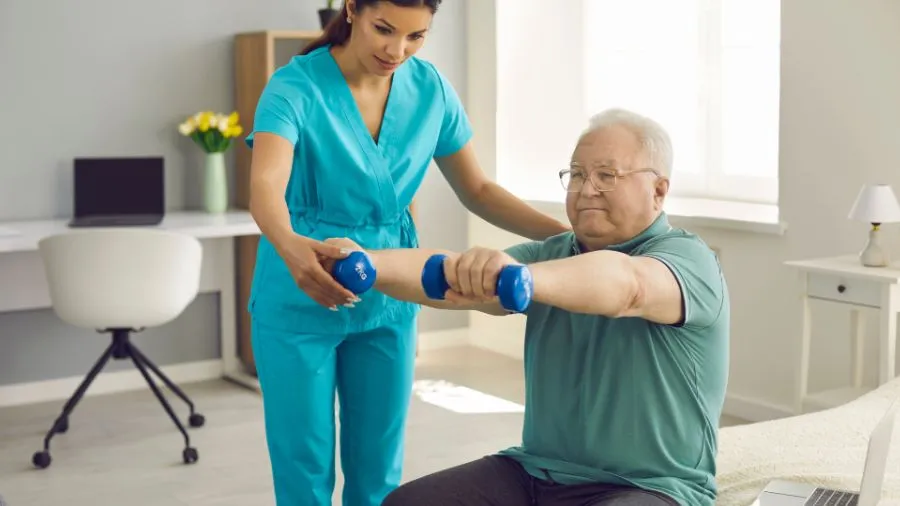Compression Flossing in Rehabilitation: A Potential Tool for Faster Recovery
Compression flossing, also known as voodoo flossing or tissue flossing, is a rehabilitation technique gaining traction in recent years. This method utilizes floss bands, similar to resistance bands, to apply targeted compression to a limb or joint. While research is ongoing to solidify its efficacy, compression flossing shows promise as a valuable tool for rehabilitation management.
Rehabilitation Management: How Compression Flossing Can Help
Rehabilitation management is a multifaceted approach aimed at restoring function, mobility, and reducing pain after injury or surgery. Compression flossing integrates with various rehabilitation strategies, potentially enhancing recovery in several ways:
- Improved Range of Motion (ROM): Compression flossing may improve joint mobility by mechanically shearing and gliding fascial layers, the connective tissue surrounding muscles. This can help loosen tight muscles and improve flexibility.
- Pain Reduction: The mechanism behind pain reduction with compression flossing is not fully understood, but it might be related to increased blood flow and the stimulation of mechanoreceptors in the compressed area, influencing pain perception.
- Enhanced Proprioception: Proprioception is your body’s awareness of its position in space. Compression flossing may improve proprioception by stimulating sensory nerves in the joints and muscles, potentially leading to better movement control.
- Faster Recovery: By potentially reducing pain and inflammation, and improving blood flow, compression flossing might accelerate the healing process after injury.
It’s important to remember that compression flossing is a relatively new technique, and more research is needed to confirm its effectiveness for various rehabilitation applications.
Here’s What You Need to Know About Compression Flossing
Here’s a deeper dive into what compression flossing entails:
- The Technique: A therapist or trained professional will apply a floss band snugly but comfortably around the target area, typically a limb or joint. The band is wrapped with moderate tension, maintaining blood flow while compressing the underlying tissues. Light movements are then performed within the available range of motion for a set time, usually around two minutes.
- Benefits: As discussed earlier, compression flossing offers potential benefits for rehabilitation management, including improved range of motion, pain reduction, enhanced proprioception, and faster recovery.
- Limitations: While promising, compression flossing is not a magic bullet. Research is still ongoing to determine its effectiveness for specific conditions. Additionally, the technique might not be suitable for everyone. Individuals with certain medical conditions or experiencing numbness or tingling during application should avoid compression flossing.
Safety and Considerations for Compression Flossing
While generally safe, compression flossing comes with some considerations:
- Professional Guidance: It’s crucial to seek guidance from a qualified physical therapist or healthcare professional before attempting compression flossing. They can assess your suitability for the technique and instruct you on proper application to maximize benefits and minimize risks.
- Individualized Approach: Compression flossing should be tailored to your specific needs and condition. A therapist can determine the appropriate pressure, duration, and frequency of flossing for optimal results.
- Listen to Your Body: Pain or discomfort during compression flossing is a sign to stop and consult your healthcare provider.
Conclusion
Compression flossing is an emerging technique in rehabilitation management. While research is ongoing, it shows promise for improving range of motion, reducing pain, enhancing proprioception, and accelerating recovery. If you’re considering compression flossing as part of your rehabilitation plan, consult a qualified healthcare professional to ensure it’s safe and appropriate for your specific needs.
Sources:
- This article summarizes information from the following recent sources (all published after 2011):
- Tissue Flossing – Physiopedia [invalid URL removed]
- What Is Voodoo Flossing, and Should You Try It? – Healthline [invalid URL removed]
- The Effect of Tissue Flossing Technique on Sports and Injury Prevention and Rehabilitation: A Systematic Review of Recent Research – ResearchGate




